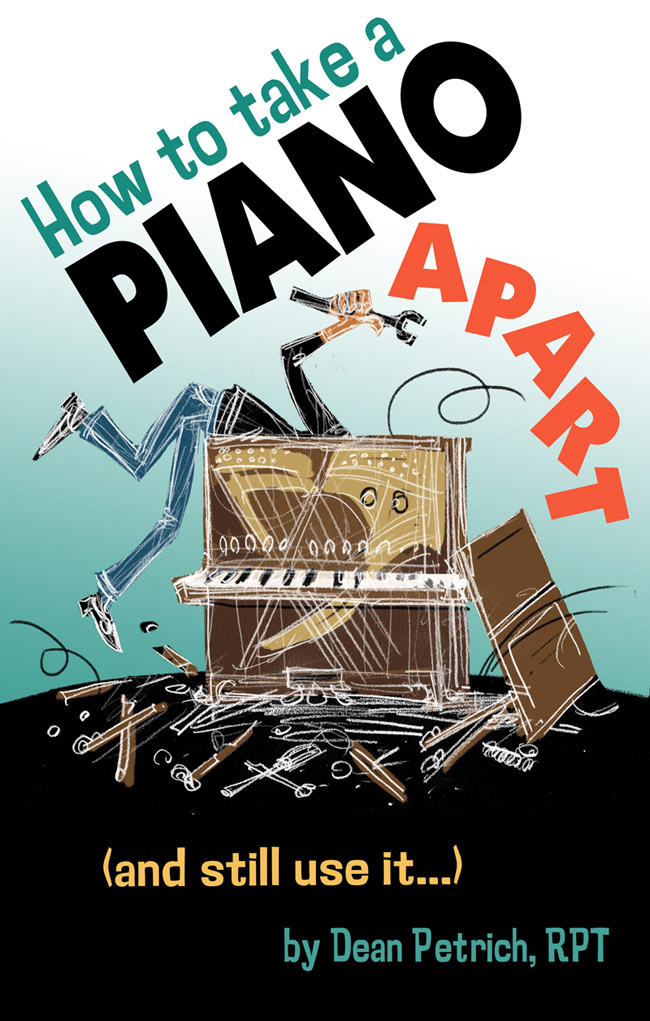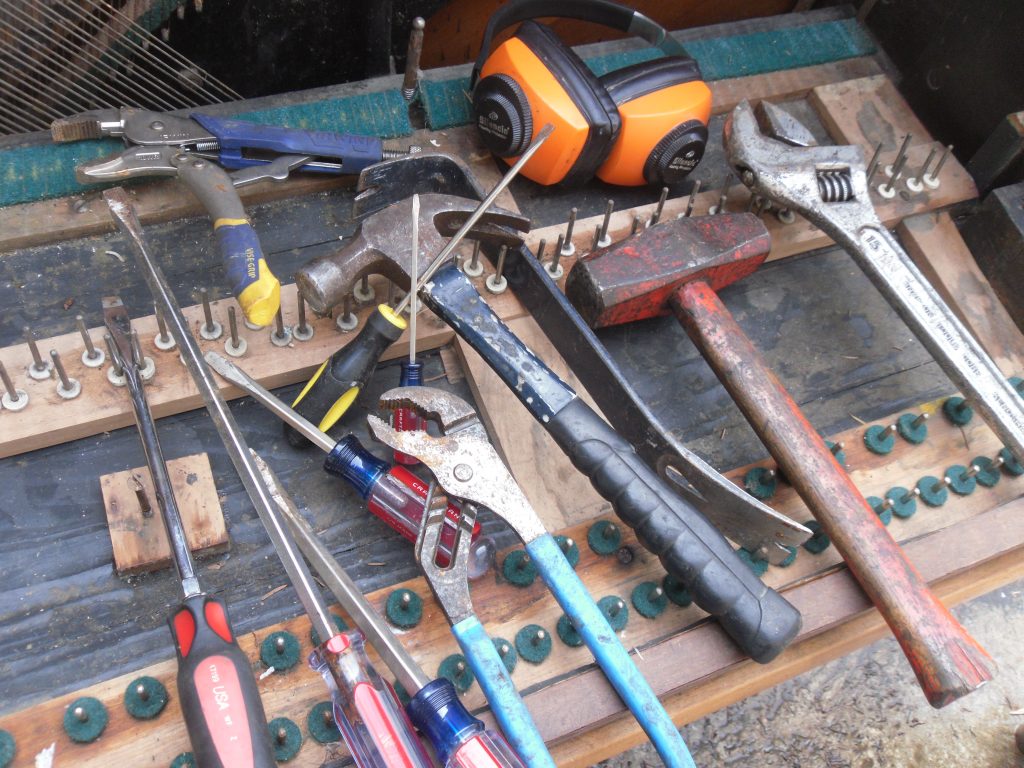Piano Dismantling
How to Dismantle a Piano Systematically

There are several ways to dismantle a piano, from brute force, a sledge hammer and a chain saw, to the systematic removal of each piece, which is cleaner, more practical, and, of course, the most thorough way to recycle all the parts.
Described here is an orderly procedure for dismantling a piano, as well as ideas of categorizing the parts once the piano is in pieces.
Click on each step to read detailed instructions.
Piano Dismantling Procedure

- What type of damage has been done?
- Smoke & fire damage
- Structural abuse
- Water damage
- Vandalism
- Rodents
- Mold
- Exterior
- Warped
- Veneer fallen off
- Severe water damage
- Soundboard buckled & ribs unglued
- Separation of sides, bottom, pin-block from backboards
- Interior
- Metal parts rusty
- Action parts unglued, broken, missing, rusted
- Bridges split or unglued
- Keys warped, broken or missing
- Relative Value
- Overall value of condition of piano vs. equivalent pianos
- Amount of time required to rebuild the piano
- Mark Status of Piano
- White tape = save for sale or for rent
- Green tape = give away for free: donate
- Red tape = dismantle
- Record piano name & serial number
- Gather Tools
- Screwdrivers
- Large crescent wrench
- Vice grips
- Hammer
- Small sledge hammer
- Large sledge hammer
- Pry bar
- Flat bar
- SawZaw
- Drill
- Grinder
- Ear protectors
- Eye protection
- Gloves
- Remove Action
- Save good actions with other actions: store vertically (Every single action part can be removed, saved and re-used)
- Set bad actions on future burn pile (Burn parts containing metal on concrete for easy clean-up)
- Remove Keys
- Place keys in a bucket, box or bag to be disassembled later
- Save keys
- If the keys are in excellent shape, keep the entire set
- Good keys can be cut, glued, and spliced for repairing broken keys on other pianos
- If the keys are not perfect, save only the parts
- Save key parts
- Capstan screws
- Accidentals are always useful for replacing missing sharps on customers’ pianos
- Having a wide selection of styles helps matching replacements to originals.
- Real ebony is becoming quite valuable
- Key buttons
- Ivory heads and tails, and sometimes fronts
- Ivory is becoming increasingly rare
- Plastic key tops if they are re-usable.
- Plastic key tops can be used for other purposes
- House key rings
- Dividers in file cabinets
- Mosaics
- Key leads
- Plastic key tops can be used for other purposes
- Save keys
- Place keys in a bucket, box or bag to be disassembled later
- Punch out key leads wearing gloves &mask
- Key sticks without leads can be used for other purposes
- Lead can be sold
- Key sticks
- A large collection of key sticks can be donated to a school class for doing art work
- Key sticks can be made into wedges or used as straight edges
- Wooden key sticks make great kindling
- Key sticks
- Remove Turn Pieces
- Music boards are popular for artists
- Side posts make wonderful shelf supports, window trim
- Music support board makes a perfect narrow wall shelf
- Fall boards placed vertically add interest to room corners
- Key slips make interesting boarders. Save the key slip screws
- Bottom boards make light-weight work-benches and tables, or wide shelves
- Legs make unique decorative additions
- Much of the wood is perfect for wood carvers
- All piano wood makes excellent fire wood
- Create a System
- Gather various sizes of containers
- Cans, buckets, large plastic containers, drawers
- Construct racks for storing long pieces
- Separate rusty parts from good parts
- Separate sizes and types of screws in individual containers
- Gather various sizes of containers
- Unscrew all metal parts
- Hinges
- Latches, swivels, locks
- Pedals
- Casters
- Rods, V-bars, brackets, guides
- Agraffes
- Screws and bolts
- Save all screws and bolts
- For difficult screws, use a large crescent wrench on a square-shank screwdriver, or for bolts use a socket with a long handle
- If available, use a power drill
- Tilt the piano back on a tilter
- Make life easy: reduce bending over and kneeling
- Remove the sides, bottom and key bed
- Unscrew the four large key bed screws that hold the key bed to each side
- A sledge hammer will remove these parts quickly
- Each side can be sledged off in one or two blows.
- Knock the sides close to the key bed framework.
- Sledge the key bed from the bottom in one blow
- Knock off the bottom board
- If any of the piano top remains, pry or knock it off
- Once apart, individual screws and hardware can be removed easily
- Remove piano wire
- Optimal tools for removing piano wire
- Using a metal grinder, cut all the piano wire just below the tuning pins
- If you don’t have a metal grinder, use a hammer and becket breaker
- If you don’t have a becket breaker, use wire cutters
- Metal container
- Dedicate a clean large plastic garbage can for metal recycling
- Since metal gets heavy, it helps to have a can with wheels
- Store all piano wire, tuning pins, bent screws, cracked plates
- Pull out all the wire and place it in the metal-recycling container
- Wear eye protection or close your eyes while handling wire
- Sometimes it helps to hold handfuls of wire in the center and to push the wire down in the middle, so the wire centers go deep but the ends stick up
- Sometimes it helps to hold handfuls of wire in the center and to push the wire down in the middle, so the wire centers go deep but the ends stick up
- Dedicate a clean large plastic garbage can for metal recycling
- Drill out all the tuning pins
- Unscrew and remove the V-bar
- If there is no wire attached to the pins, offer them on Craig’s List. It is amazing the number of uses people come up with for tuning pins.
- If the pins are trashed and rusted and there is no time to remove the wire from them, put them in the metal recycling bin
- Optimal tools for removing piano wire
- Remove all the bolts, metal posts, plate nuts and screws
- Save the hardware in dedicated containers
- Salvage all pedal parts
- Salvage the casters and caster plates
- Lift out the plate
- Give the plates to artists or to someone who wants to build a fence
- Recycle the iron
- Donate the iron to a non-profit organization
- Flip the piano over
- Remove the back posts and pin block
- Sledge or pry off any remaining bottom boards
- Sledge out the bottom blocks
- Remove the back posts
- Sometimes the posts can be sledged apart
- If they can’t, cut the back posts off the pinblock with a SawZawcircular
- A SawZaw is quickest and easiest
- A circular saw will not cut through, but might cut enough to sledge off the rest
- A chain saw is quick, but noisy
- Soundboard
- Good condition: save it to make things
- Table
- Wall
- Art piece
- Material for a musical instrument
- Bad condition: break apart, or cut up into kindling with a saw
- Bridges
- Remove pins and make into things
- Frame for key hooks at a school
- Glue multiple bridges together for 3-D art
- Construct marble-rolling toys
- Leave pins in the bridge
- Burn and then discard the metal
- Use as a scraper or roughing tool
- Use bridge as a destructive weapon
- Remove pins and make into things
- Good condition: save it to make things
- Remove the back posts and pin block
- Burn mixed wood &metal
- Find a safe spot for a large fire
- Check on the burn ban requirements
- Burn all parts containing metal that cannot be removed
- Once burnt, pull out all metal for recycling
- What remains goes to the landfill: this should be a small amount
- Firewood
- Let people know that you have some unusual wood pieces
- Any remaining wood that has not been spoken for can be cut up for burning
- Don’t just have a bon fire: burn the wood as needed to heat in the winter
- Now you know how I heat my house
For a precise idea of what it takes to dismantle and restore a piano, watch this thorough video: